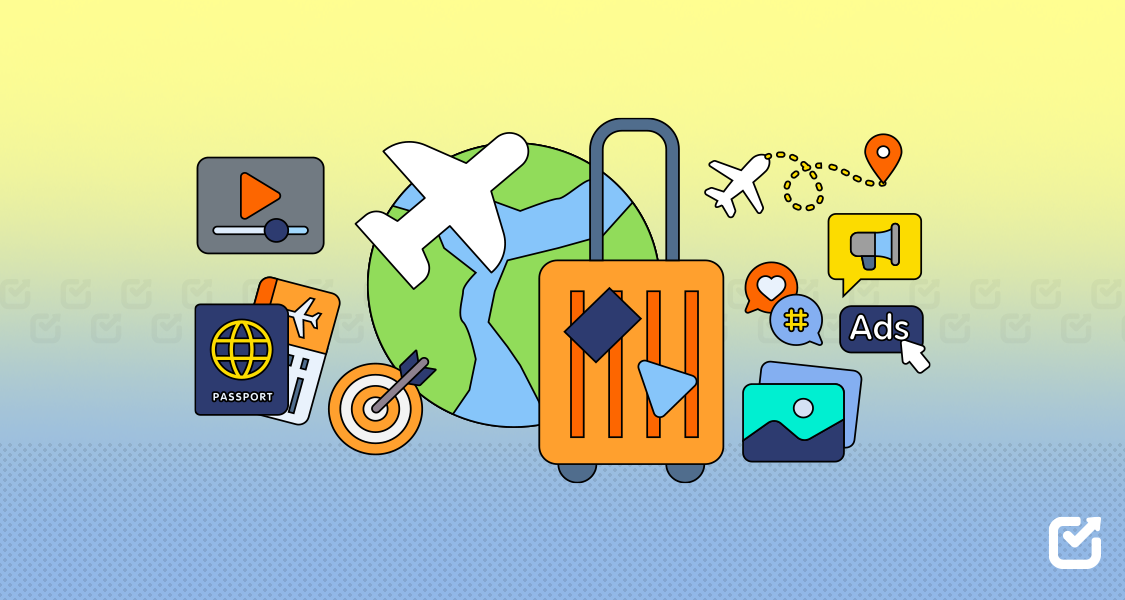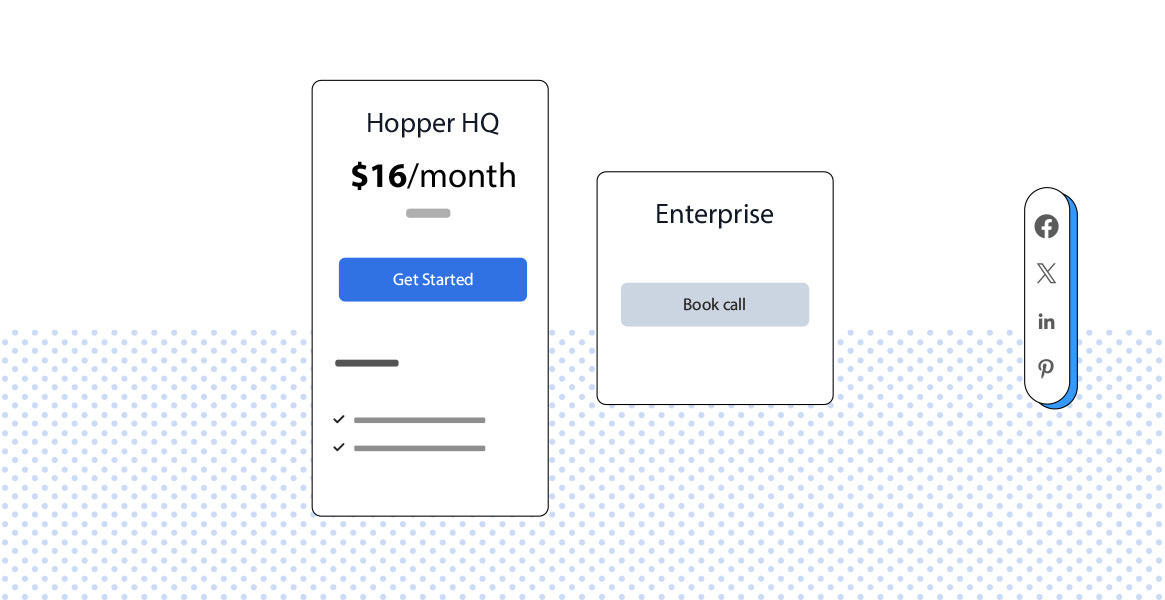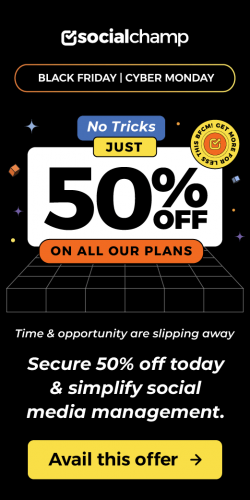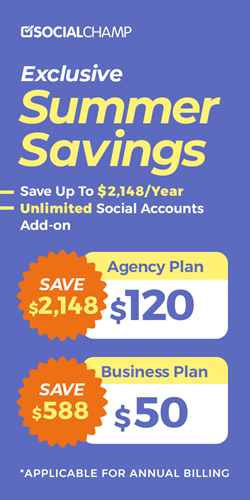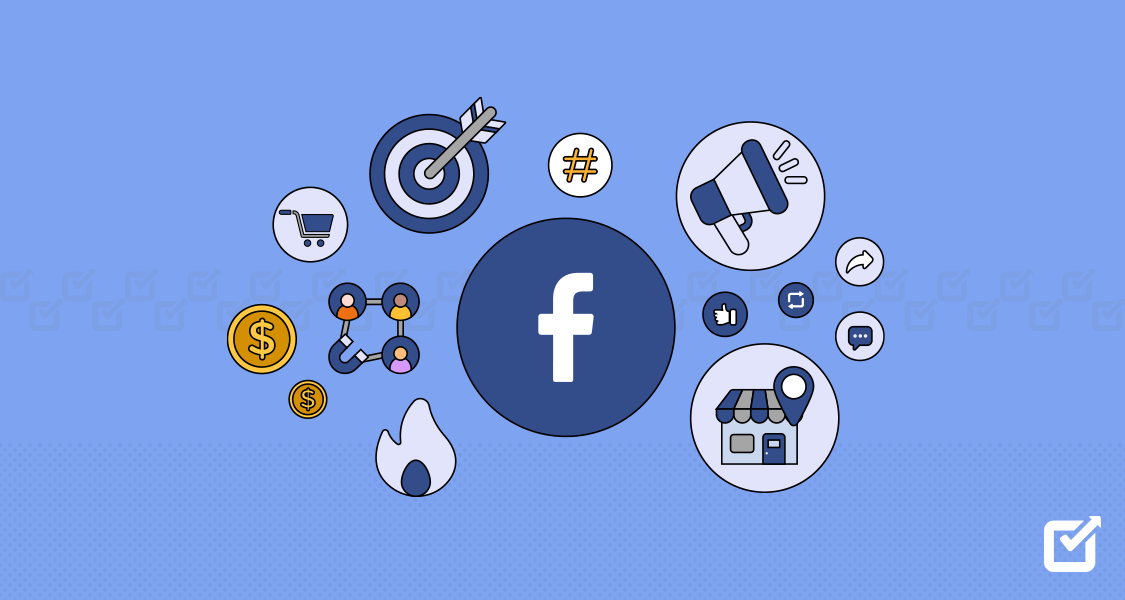How do today’s travelers find their next adventure?
Spoiler alert: it’s not by walking into a storefront agency or flipping through a brochure.
Research shows that more than 80% of travel planning starts online, and over 70% of bookings are made digitally.
That means if you are not leveraging digital marketing for travel industry, you’re missing out—big time.
But you don’t need a massive budget or a full marketing team to make an impact.
With the right social media management tools, travel agents can attract more clients, build lasting relationships, and turn interest into actual bookings—all while standing out in a highly competitive market.
In this blog, we’ll break down the digital marketing tactics that work best for travel agents.
Whether you’re a solo agent or run a small team, these insights will help you grow your business and stay ahead of the curve in the ever-evolving travel landscape.
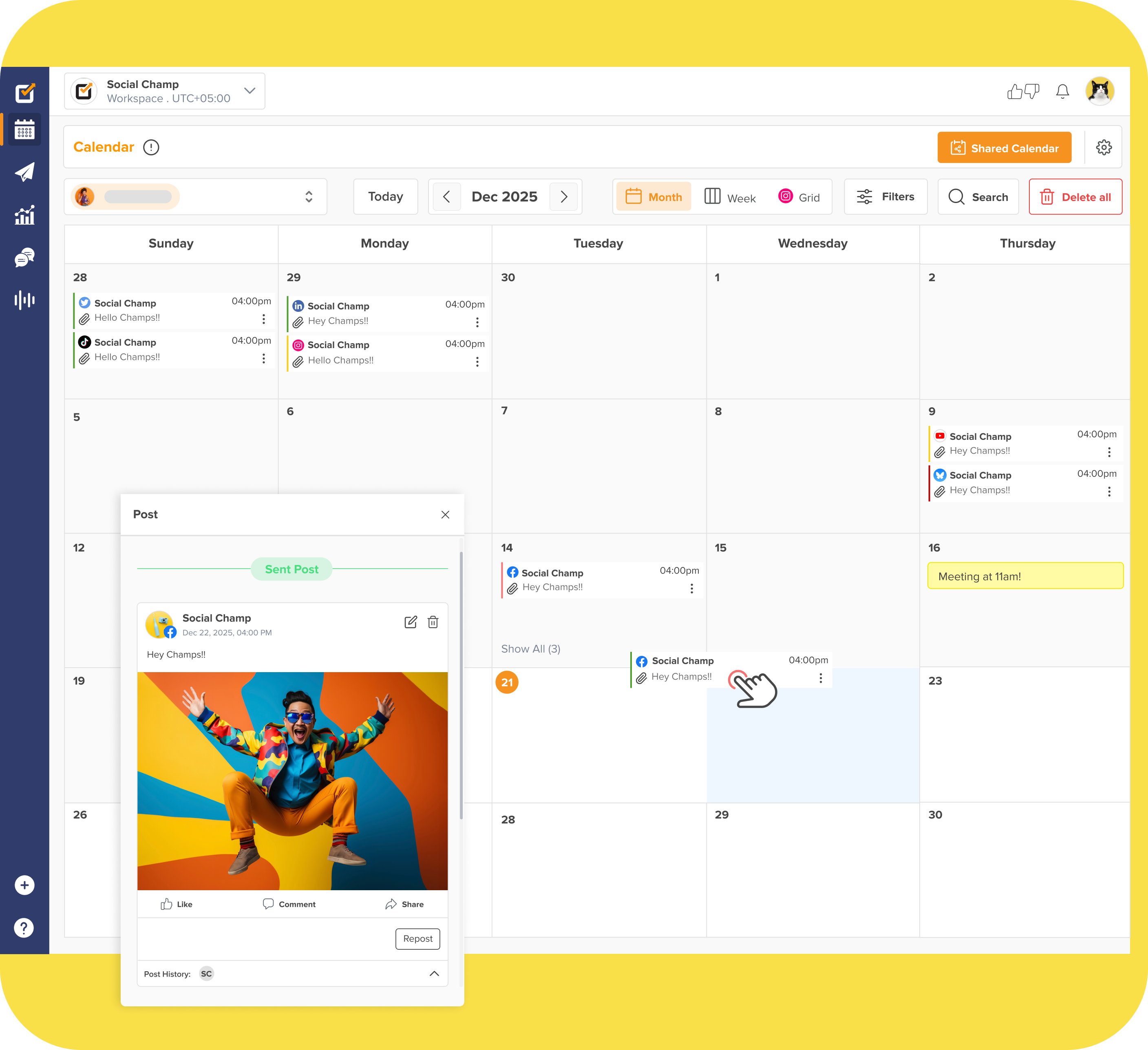
Show Up on Your Customers’ Feed With Social Champ!
Social Champ puts your travel brand on autopilot—so you’re always present, always polished, and always one scroll away from your next client. Start your free trial now!
Short Summary
- Today’s travelers plan and book online—over 80% of planning and 70% of bookings happen digitally.
- Platforms like Instagram and TikTok are powerful tools for showcasing destinations and engaging travelers visually and emotionally.
- SEO helps travel brands appear in search results just when potential clients are actively planning trips.
- Email marketing keeps your agency top-of-mind with personalized campaigns, exclusive offers, and content tailored to past behavior.
- Social Champ simplifies social media marketing for travel businesses with scheduling, analytics, UGC tools, and collaboration features.
- Great digital marketing is about connection, inspiration, and being present at every stage of the traveler’s journey.
Understand Your Audience’s Travel Preferences
To market travel effectively, you need to know who you’re talking to—and more importantly, what your audience is dreaming about.
Are your ideal clients young solo travelers chasing adventure, families seeking all-inclusive getaways, or retirees looking for luxury cruises?
Each group has unique preferences, planning habits, and digital behavior.
Start by analyzing your past bookings and customer interactions.
What destinations are popular?
What types of experiences are most requested?
Dive into your CRM data or social media insights to spot patterns in age, location, travel seasonality, and budget range.
You can also use tools like Google Trends or conduct quick surveys through email or Instagram Stories to stay in tune with evolving interests.
For example, a rise in searches for “eco-friendly travel” or “offbeat destinations” could guide your next campaign.
The more you understand your audience’s travel mindset, the better you can craft targeted messages and offers that feel tailor-made—boosting engagement and, ultimately, bookings.
Identifying Traveler Personas and Preferences
Once you’ve gathered insights into your audience’s travel habits, the next step is to organize them into clear traveler personas.
Traveler personas are fictional profiles that represent different segments of your customer base, and are a crucial part of digital marketing for travel industry
Think of these personas as “avatars” that guide your marketing decisions. For instance, you might have:
- Adventure-Seeking Alex: A 28-year-old solo traveler who values experiences over luxury and books last-minute trips via mobile.
- Family-Adventurist Priya: A 40-year-old mom who books months in advance, wants kid-friendly activities, and prefers all-inclusive resorts.
- Luxury-Lover Liam: A 60-year-old retiree seeking first-class flights, private tours, and high-end accommodations.
- Once these personas are defined, they become the backbone of your digital strategy. Here’s how:
- Ad Targeting: Use detailed audience filters on platforms like Facebook and Google Ads to serve relevant content to each persona.
- Content Creation: Craft blogs, emails, and social media posts that speak directly to each group’s interests, questions, and pain points.
- Email Segmentation: Send tailored offers—like early-bird deals for families or exclusive luxury packages—to the right audience segment.
- Personalization: Use dynamic content on your website to show destination ideas or testimonials that match the visitor’s persona profile.
Featured Article: Social Media for Investors: The Ultimate Guide to Marketing in 2025
Leverage Social Media Platforms for Destination Promotion
Social media has become one of the most influential tools in travel marketing, and for good reason.
Platforms like Instagram, TikTok, Facebook, and even Pinterest are where modern travelers go to discover new destinations, get inspired by real experiences, and plan their next adventure—often before they even visit a website or talk to an agent.
Why Instagram and TikTok Matter
Instagram is the visual heart of travel storytelling.
With its focus on high-quality photos, Stories, and Reels, it’s perfect for highlighting everything from picturesque beaches to unique boutique stays.
Travel agents can use Instagram to:
- Post carousel tips like “Top 5 Things to Do in Santorini.”
- Share short-form Reels of hotel tours or scenic experiences.
- Use Story polls and Q&As to spark interaction and learn more about what followers want to see.
- Create saved Highlights categorized by destination or travel type (honeymoon, family travel, solo trips, etc.).
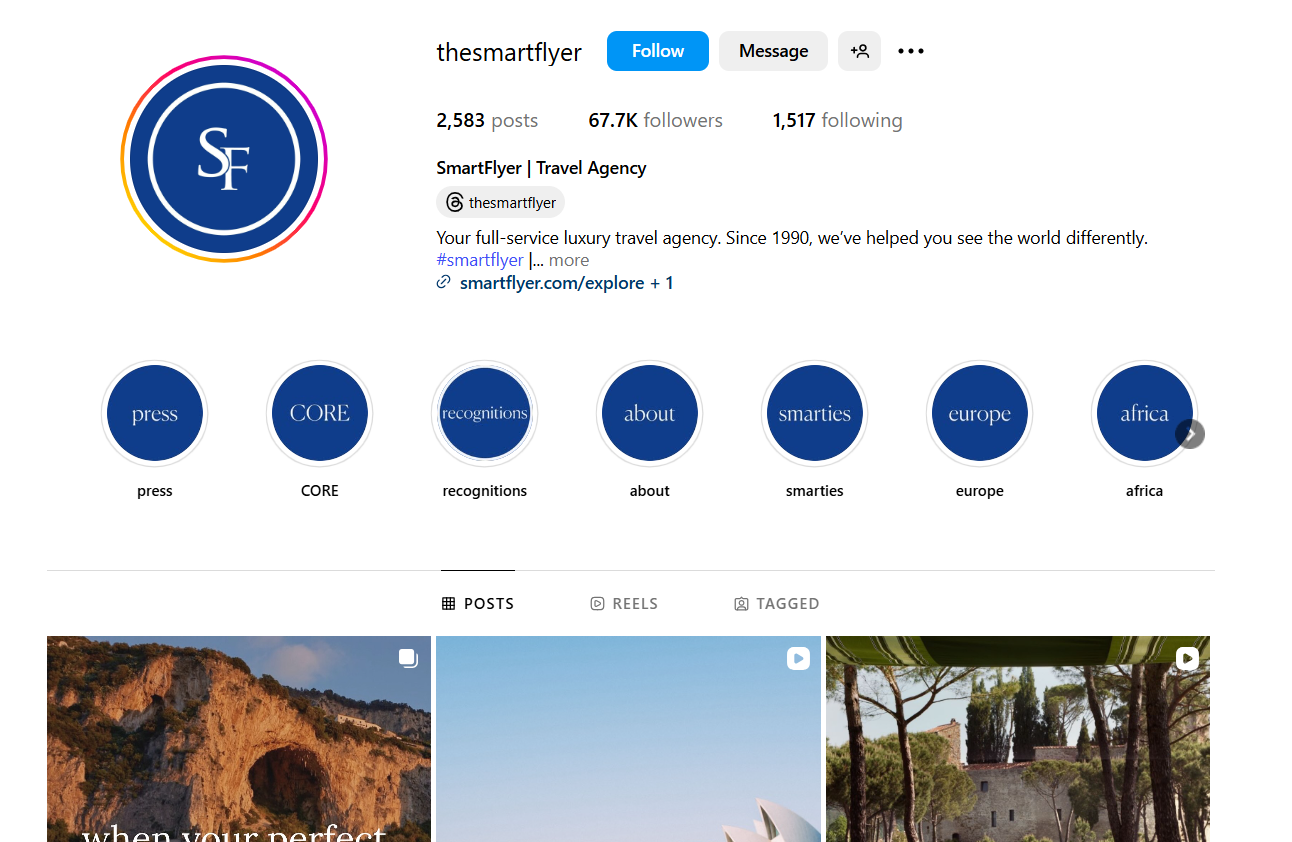
TikTok, on the other hand, thrives on authenticity and discovery. It’s less polished, more personal—and often more viral. Agents can gain traction by:
- Sharing quick destination facts, packing tips, or cultural insights.
- Telling mini travel stories (“Here’s how I helped a client plan a surprise honeymoon to Italy…”).
- Jumping on trending sounds or challenges to boost visibility.
- Collaborating with influencers or content creators who align with your brand.
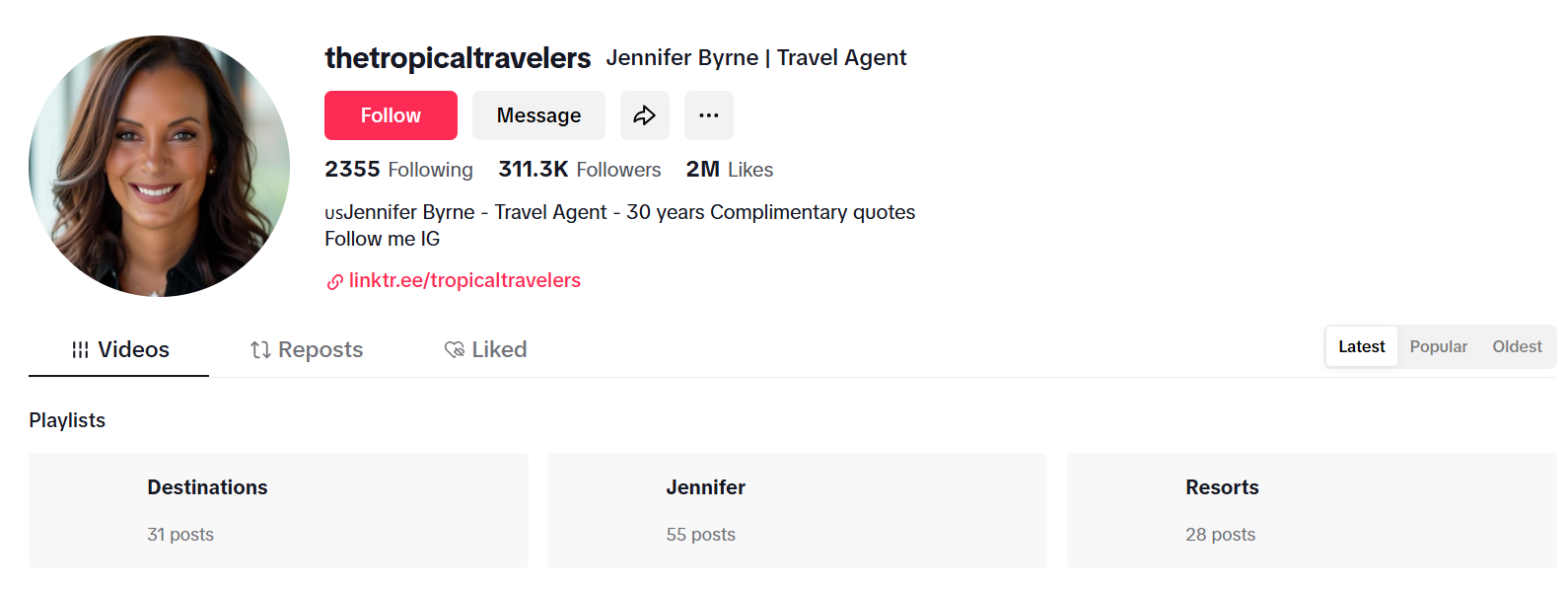
thetropicaltravelers’s TikTok Profile
Engaging Potential Travelers
It’s not just about posting—it’s about creating two-way engagement:
- Reply to comments and DMs promptly to build trust and show you’re active.
- Encourage followers to share their own travel experiences with a branded hashtag.
- Run destination-based contests or giveaways to grow your audience.
- Use call-to-actions like “Save this for later!” or “Tag someone you’d travel here with!”
Data-Driven Promotion
Social platforms also offer robust ad targeting tools. You can run paid campaigns that:
- Target users based on recent travel interest, age, location, and behaviors.
- Retarget website visitors or people who engaged with your posts.
- Promote limited-time offers or seasonal trips.

Your Competitors Are Tracking—Are You?
Social Champ’s analytics give you real-time insights into what’s driving your audience to book—and what’s not. The numbers don’t lie. Start tracking today!
Implement SEO Strategies to Increase Online Visibility
When travelers start planning a trip, where do they turn first?
Most begin with a simple Google search—“best honeymoon spots in Europe,” “things to do in Bali,” or “family-friendly resorts in Florida.”
That’s where Search Engine Optimization (SEO) comes in.
By optimizing your travel agency’s website for relevant search terms, you can attract a steady stream of organic traffic—people who are already looking for exactly what you offer.
Why SEO Matters for Travel Agents
SEO isn’t just about ranking high on Google—it’s about being discoverable at the moment of intent.
A traveler searching for “custom Italy tours” is already in the mindset to plan and potentially book.
If your content appears in their search results that means you’re on the right track of digital marketing for travel industry. You’ve got a golden opportunity to connect before they even consider a competitor.
Key SEO Tactics That Drive Results
Here’s how you can boost your visibility and draw in more qualified leads:
Keyword Research: Use tools like Google Keyword Planner, Ubersuggest, or Semrush to find what your ideal clients are searching for. Focus on long-tail keywords like “affordable safari packages for families” or “best time to visit the Maldives for honeymooners.”
Optimized Blog Content: Create helpful, well-structured blog posts around popular questions or travel themes. Example: “7 Hidden Gems in Greece You Can’t Miss” or “How to Plan a Stress-Free European Rail Trip.”
On-Page SEO Basics:
- Include keywords in your page titles, meta descriptions, and headers.
- Use internal linking to keep users engaged and reduce bounce rates.
- Optimize images with descriptive alt text (great for both SEO and accessibility).
Local SEO: Don’t forget to optimize for local searches if you serve a specific area. Claim and update your Google Business Profile, get reviews, and include location-specific keywords like “Toronto travel agency for Europe trips.”
Technical SEO: Make sure your site loads fast, is mobile-friendly, and has a clear structure so search engines can easily crawl and index your content.
SEO Is a Long-Term Game
Unlike paid ads, SEO continues to deliver traffic over time without ongoing costs. A well-optimized blog post can bring in leads for months or even years after it’s published.
It helps establish your agency as a trusted source of information and keeps your brand top-of-mind when it’s finally time to book.
Utilize Email Marketing to Nurture Leads and Encourage Repeat Bookings
Email marketing remains one of the most powerful tools for maintaining relationships with past customers and encouraging future bookings.
While many people might assume email is outdated, in reality, it has an incredibly high return on investment (ROI)—especially when it comes to the travel industry.
Here’s how you can retain your customers with email marketing:
-
Creating Targeted Campaigns Based on Past Travel Data
By analyzing the past booking history of your customers, you can craft personalized email campaigns that cater specifically to their travel preferences.
For example, if a customer previously booked a luxury resort in the Maldives, sending them an exclusive offer for a similar high-end beach destination will feel highly relevant.
These targeted emails remind them of the great experiences they had with your agency, and offer suggestions for their next adventure.
-
Delivering Timely and Relevant Offers for Future Travel
Timing is everything when it comes to email marketing.
Personalized offers that align with key milestones—like anniversaries, birthdays, or the seasonality of a destination—can significantly boost engagement.
For instance, a family that previously booked a spring break getaway could be interested in offers for their next vacation, whether it’s a summer trip or a winter holiday.
Sending these timely emails ensures your customers feel that your agency is anticipating their needs and planning their next perfect trip.
-
Re-engaging With Abandoned or Inactive Customers
Sometimes customers simply need a nudge to reignite their travel plans.
Personalized email campaigns can reach out to those who haven’t booked in a while, offering them a special promotion, reminder of past trips, or new destination suggestions.
For example, you could send a personalized message reminding them of an unforgettable experience they had, followed by a tailored recommendation for a future trip.
This helps rekindle interest and encourages customers to consider booking again.
-
Building Long-Term Relationships With Exclusive Content
Beyond promotions, a great way to maintain engagement with past customers is by providing them with valuable and exclusive content.
This could be a curated travel guide for a destination they’ve shown interest in, tips on local experiences, or packing lists for an upcoming trip.
By consistently offering content that resonates with their interests, you remind them why they trusted your agency in the first place, helping to keep your brand top-of-mind.
-
Nurturing Customer Loyalty Through Personalized Touchpoints
Personalized email campaigns aren’t just about booking trips—they’re about building lasting relationships.
Taking the time to acknowledge special moments like a client’s birthday or the anniversary of a memorable trip creates a deeper connection.
Sending thoughtful, customized messages that offer a friendly reminder of past experiences and encourage future travel plans enhances customer loyalty and fosters trust, making them more likely to return for their next trip.
Featured Article: 13+ Best Free Social Media Management Tools Every Marketer Should Know
Incorporate User-Generated Content to Build Trust
Travel is an emotional decision, and trust plays a major role in a customer’s choice of agency or destination.
That’s where user-generated content (UGC)—real reviews, photos, and experiences shared by your clients—becomes incredibly powerful.
Showcasing authentic stories not only enhances credibility but also reassures potential clients that your services deliver on their promises.
-
Showcasing Real Experiences to Create Authenticity
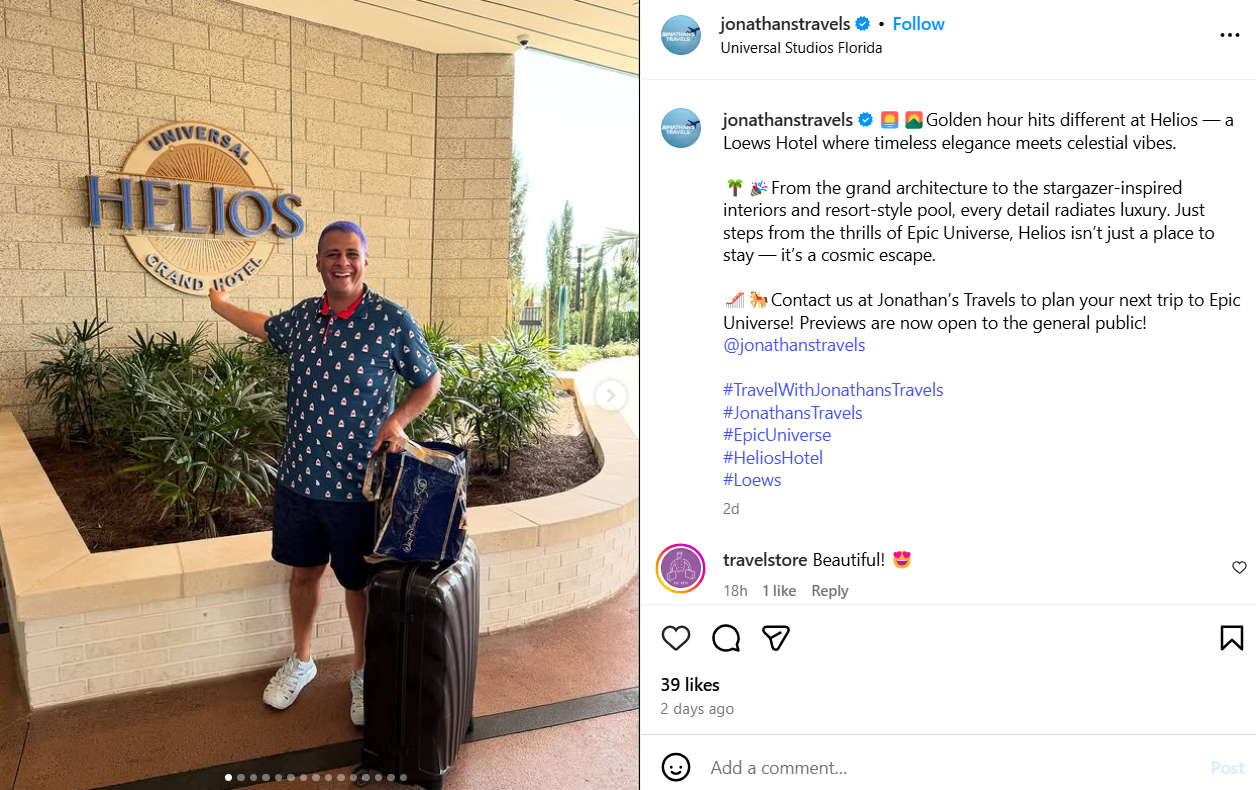
Pictures of a Real Client on @jonathanstravels’ Instagram There’s nothing more persuasive than a fellow traveler’s story. Sharing photos, videos, or testimonials from your past clients brings a human voice to your marketing.
Whether it’s a glowing review of a honeymoon you helped plan or an Instagram post of a client enjoying a food tour in Spain, these real-world experiences feel relatable and trustworthy.
Potential customers are far more likely to be influenced by genuine content than by polished brand messages alone.
-
Turning Happy Clients Into Brand Advocates

Customer Feedback on @libertytravel’s Instagram Page Your most satisfied travelers are your best marketers.
When you encourage clients to share their experiences and tag your agency on social media, you’re not just getting content—you’re getting advocacy.
Reposting these moments with permission allows you to highlight the positive impact of your services in a way that feels organic.
This peer-to-peer validation can help hesitant prospects take the next step toward booking.
-
Integrating Reviews and Testimonials Across Channels
Don’t limit UGC to just social media.
Featuring client testimonials and reviews on your website, in email campaigns, and across landing pages strengthens your credibility across the customer journey.
For instance, including a short review on a booking page can be the final push a new visitor needs to make a decision.
The key is consistency—make sure potential clients encounter social proof at every key touchpoint.
-
Encouraging Ongoing Engagement Through Storytelling
Invite your clients to share their travel stories through contests, hashtags, or post-trip follow-up emails.
Ask questions like “What was the most unforgettable moment of your trip?” or “Would you recommend this destination to others?”
Their answers not only provide you with powerful content but also make clients feel valued and heard.
This engagement deepens your connection with them and increases the chances they’ll return—and refer others.
-
Building a Community That Fuels Future Bookings
When prospective travelers see a community of real people enjoying the trips you’ve planned, it sparks a sense of belonging and excitement.
Highlighting UGC regularly helps create a dynamic, engaged audience that sees your brand as more than a service provider—it becomes part of their travel lifestyle.
This social validation turns interest into action, often making the difference between browsing and booking.
Featured Article: What Is a UGC Creator and How to Become One in 2025?
How Social Champ Simplifies Marketing for Travel Brands
Social Champ is a powerful ally for travel agents and tour operators looking to streamline their social media presence, save time, and attract more clients.
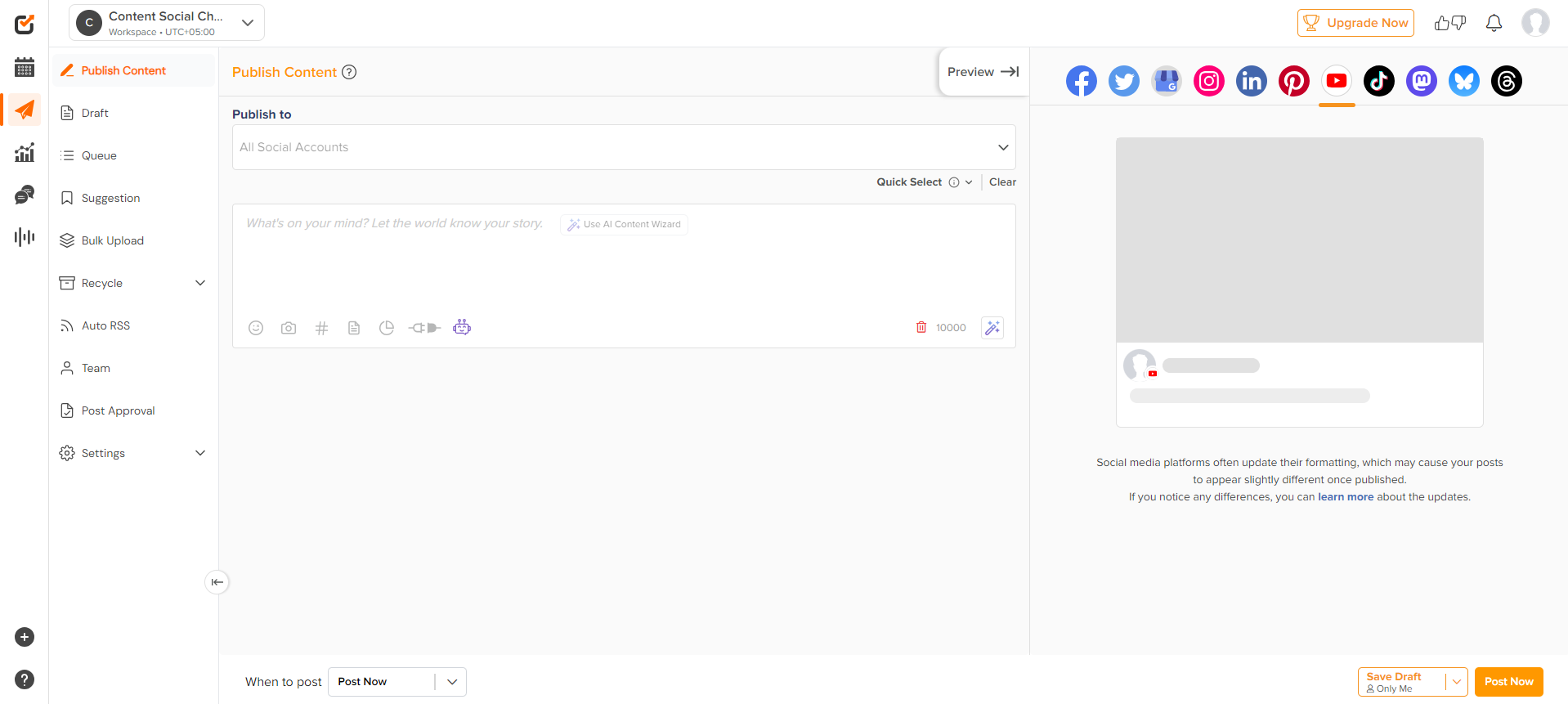
Here’s how it helps:
- Automated Post Scheduling
- Schedule content across platforms like Instagram, Facebook, Twitter, LinkedIn, Pinterest, and YouTube—weeks or months in advance—ensuring consistent visibility even during busy seasons.
- Unified Content Calendar
Plan and visualize your content strategy with a drag-and-drop calendar that makes it easy to align posts with travel seasons, promos, and destination launches. - Bulk Upload for Campaigns
Upload multiple posts in one go for campaigns like seasonal offers, last-minute deals, or new package rollouts—saving you hours of manual work. - Recycle Evergreen Travel Content
Automatically repost popular content such as travel tips, destination guides, or client testimonials to keep engagement high without constant content creation. - Optimal Post Timing Suggestions
Post when your audience is most active with intelligent scheduling suggestions based on engagement data, helping you maximize reach and interaction. - Custom Branding and Hashtag Management
Save and reuse branded hashtags, captions, and signature travel phrases to maintain consistency across posts and reinforce your agency’s identity. - Content Curation Tool
Discover trending travel news, blogs, and stories to share with your audience—perfect for keeping your social feeds fresh and relevant. - Client Testimonials and UGC Scheduling
Easily upload and share user-generated content and customer reviews from satisfied travelers to build trust and authenticity. - Team Collaboration Features
Assign roles and permissions to team members, streamline approval workflows, and collaborate on content creation without losing oversight. - Performance Analytics Dashboard
Monitor reach, clicks, engagement, and follower growth across all channels. Identify what content resonates best with travelers and refine your strategy accordingly. - Media Library for Visual Assets
Store and organize high-resolution travel photos and videos, making it easy to access visual content for campaigns and daily posts. - Campaign Tracking and Reporting
Generate detailed reports on campaign performance to measure ROI and share results with stakeholders or partners. - Chrome Extension for Quick Sharing
Instantly share interesting travel articles, blog posts, or photos from the web to your social channels with just one click. - Mobile App Access
Manage your travel brand’s social media on-the-go—perfect for agents who travel frequently or operate remotely.

Travel Agents: The Algorithm Isn’t Waiting—Why Are You?
Social Champ helps you schedule smarter, stay consistent, and flood feeds with stunning content—while you focus on planning unforgettable journeys. Get in now!
Conclusion
Let’s face it—travelers today aren’t just booking trips; they’re dreaming, researching, scrolling, and comparing long before they click “confirm.”
That’s why digital marketing for travel industry isn’t just nice to have—it’s essential.
Whether you’re building out beautiful Instagram reels, sending personalized emails, or showing up in search results at just the right moment, every touchpoint matters.
With the right strategies—and a tool like Social Champ in your corner—you can keep your travel brand active online without burning out.
Schedule posts in advance, share real stories from happy clients, stay in front of your audience, and make it easier for them to say “yes” to their next adventure.
Start small, keep showing up, and most importantly—make it feel personal. Because at the end of the day, great marketing isn’t just about selling a trip. It’s about inspiring the journey.
